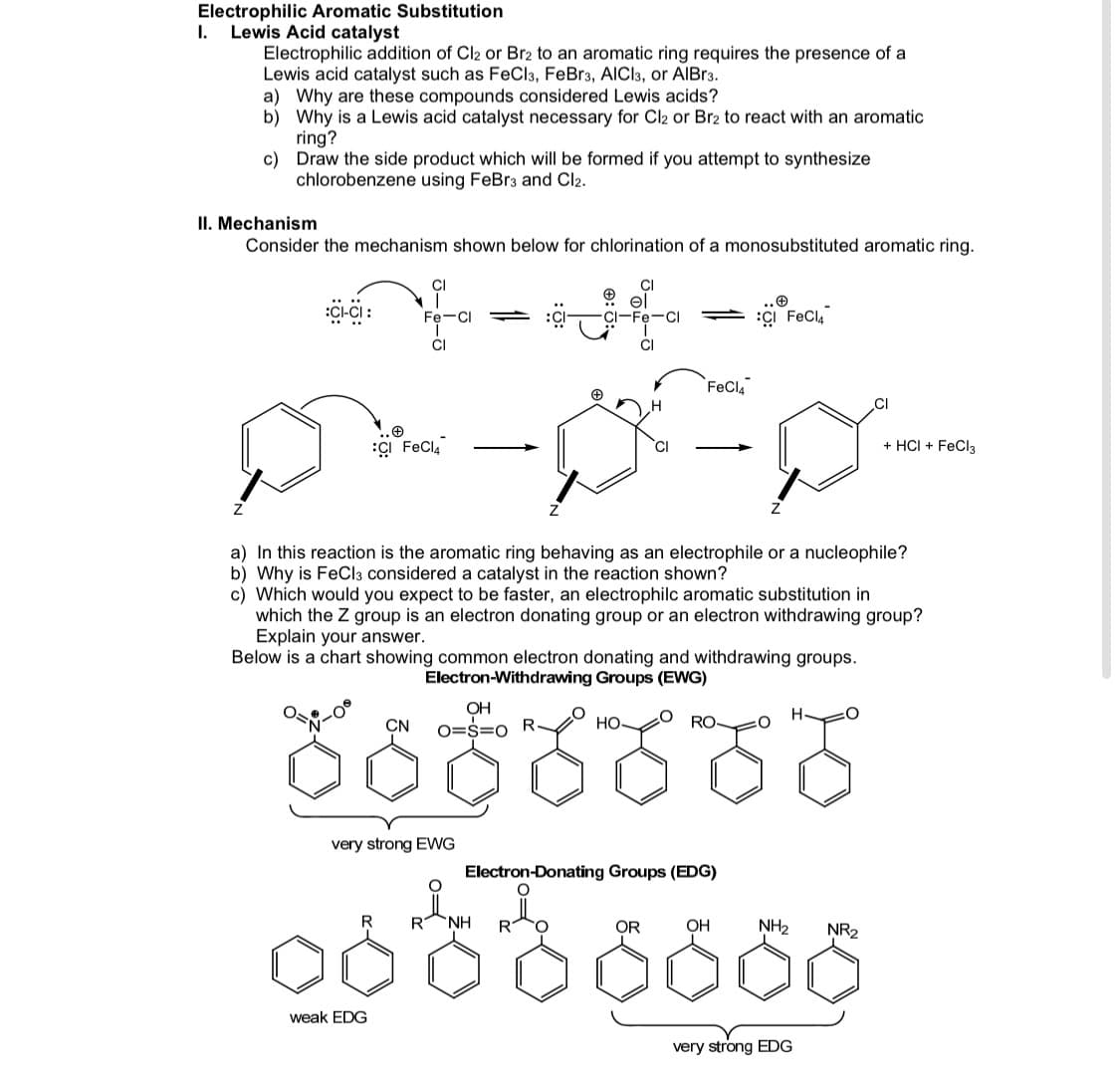I. Lewis Acid catalyst Electrophilic addition of Cl2 or Br2 to an aromatic ring requires the presence of a Lewis acid catalyst such as FeCl3, FeBr3, AICI3, or AIBR3. a) Why are these compounds considered Lewis acids? b) Why is a Lewis acid catalyst necessary for Cl2 or Br2 to react with an aromatic ring? c) Draw the side product which will be formed if you attempt to synthesize chlorobenzene using FeBr3 and Cl2.
I. Lewis Acid catalyst Electrophilic addition of Cl2 or Br2 to an aromatic ring requires the presence of a Lewis acid catalyst such as FeCl3, FeBr3, AICI3, or AIBR3. a) Why are these compounds considered Lewis acids? b) Why is a Lewis acid catalyst necessary for Cl2 or Br2 to react with an aromatic ring? c) Draw the side product which will be formed if you attempt to synthesize chlorobenzene using FeBr3 and Cl2.
Organic Chemistry: A Guided Inquiry
2nd Edition
ISBN:9780618974122
Author:Andrei Straumanis
Publisher:Andrei Straumanis
Chapter19: Eas: Electrophilic Aromatic Substitution
Section: Chapter Questions
Problem 21E
Related questions
Question

Transcribed Image Text:Electrophilic Aromatic Substitution
I.
Lewis Acid catalyst
Electrophilic addition of Cl2 or Br2 to an aromatic ring requires the presence of a
Lewis acid catalyst such as FeCla, FeBr3, AICI3, or AIBR3.
a) Why are these compounds considered Lewis acids?
b) Why is a Lewis acid catalyst necessary for Cl2 or Br2 to react with an aromatic
ring?
c) Draw the side product which will be formed if you attempt to synthesize
chlorobenzene using FeBr3 and Cl2.
II. Mechanism
Consider the mechanism shown below for chlorination of a monosubstituted aromatic ring.
CI
CI-Fe-C
ÇI FeCl,
Fe-CI
CI
FeCla
CI
ÇI FeCla
+ HCI + FeCl3
a) In this reaction is the aromatic ring behaving as an electrophile or a nucleophile?
b) Why is FeCla considered a catalyst in the reaction shown?
c) Which would you expect to be faster, an electrophilc aromatic substitution in
which the Z group is an electron donating group or an electron withdrawing group?
Explain your answer.
Below is a chart showing common electron donating and withdrawing groups.
Electron-Withdrawing Groups (EWG)
రంరంరం
OH
CN
O=S=0
НО
RO
very strong EWG
Electron-Donating Groups (EDG)
R
R NH
R
OR
OH
NH2
NR2
weak EDG
very strong EDG
Expert Solution
This question has been solved!
Explore an expertly crafted, step-by-step solution for a thorough understanding of key concepts.
This is a popular solution!
Trending now
This is a popular solution!
Step by step
Solved in 2 steps with 1 images

Knowledge Booster
Learn more about
Need a deep-dive on the concept behind this application? Look no further. Learn more about this topic, chemistry and related others by exploring similar questions and additional content below.Recommended textbooks for you

Organic Chemistry: A Guided Inquiry
Chemistry
ISBN:
9780618974122
Author:
Andrei Straumanis
Publisher:
Cengage Learning

Organic Chemistry: A Guided Inquiry
Chemistry
ISBN:
9780618974122
Author:
Andrei Straumanis
Publisher:
Cengage Learning